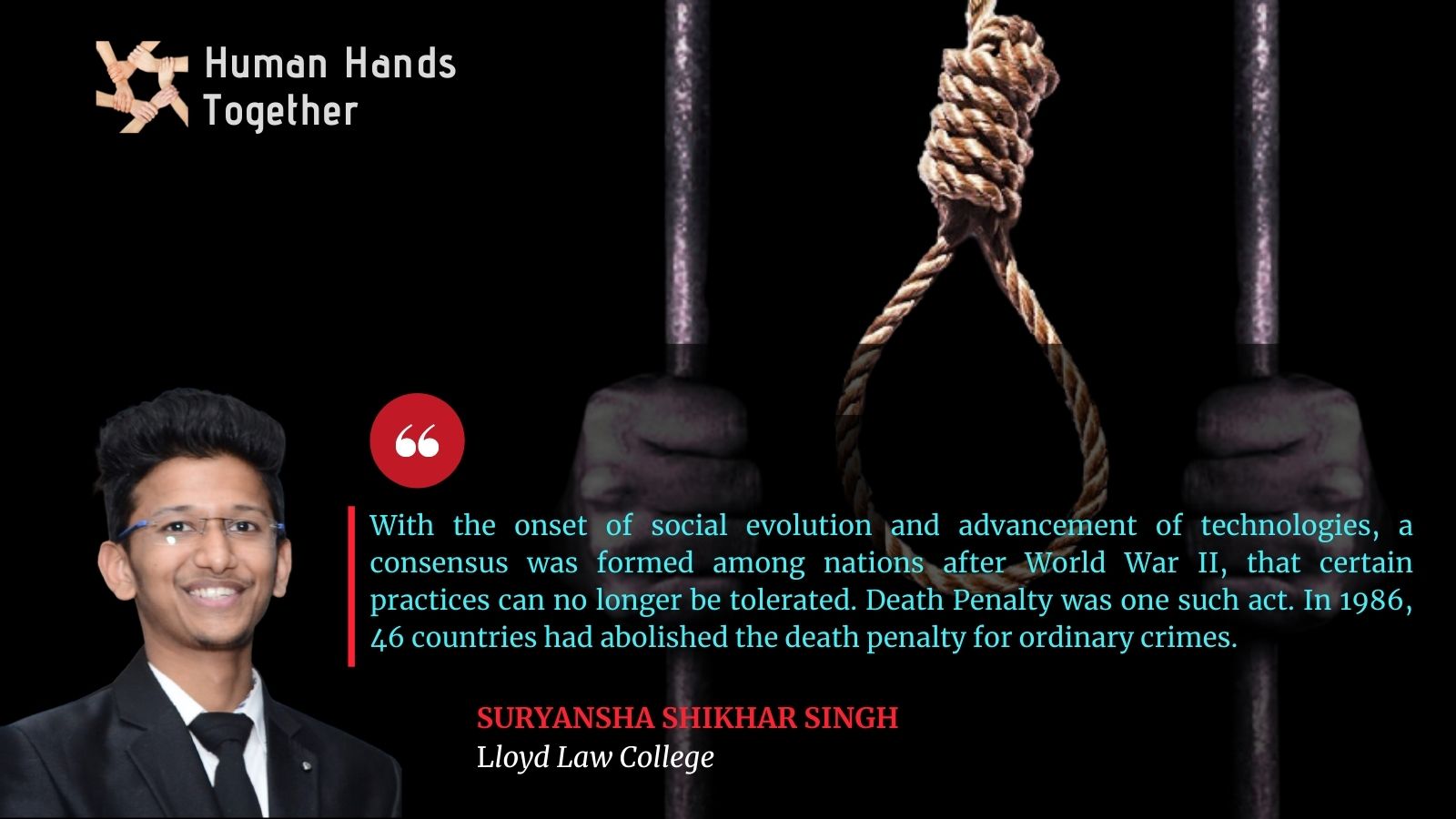- Suryansha Shikhar Singh
Lloyd Law College
With
the onset of social evolution and advancement of technologies, a consensus was
formed among nations after World War II, that certain practices can no longer
be tolerated. Death Penalty was one such act. In 1986, 46 countries had
abolished the death penalty for ordinary crimes.
Death
penalty, in a way on national and international spectrum, breaches human
rights, in particular the right to life and the right to live free from torture
or cruel, inhumane or degrading treatment or punishment. Both these rights are
protected under the Universal Declaration of Human Rights, adopted by the UN in
1948. Sixteen years later after the adoption of the said Declaration, the
number of countries in the same category had almost doubled to 89. The reasons
why countries have abolished the death penalty in increasing numbers, vary. For
some nations, it was a broader understanding of human rights. Spain abandoned the
last vestiges of its death penalty in 1995, stating that: "the death penalty
has no place in the general penal system of advanced, civilized societies. What
more degrading or afflictive punishment can be imagined than to deprive a
person of his life?" And for some it is a critical question of human
rights issue. The different execution techniques followed are
[1.]
Beheading
[2.]
Electrocution
[3.]
Hanging
[4.]
Lethal Injection
[5.]
Shooting.
In
1997, the U.N. High Commission for Human Rights approved a resolution stating
that the abolition of the death penalty contributes to the enhancement of human
dignity and to the progressive development of human rights.That resolution was
strengthened in subsequent resolutions by a call for a restriction of offences
for which the death penalty can be imposed and for a moratorium on all
executions, leading eventually toabolition. The United States is a country that
prides itself with having strong constitutional procedural safeguards
regulating the capital punishments and has efficient and effective judicial
system to ensure deliverance of the correct and just verdict. But even in this
jurisdiction, appellate courts have reversed numerous death sentences based on
procedural and evidentiary errors in the trial courts. As of 2020, most known
executions took place in China, Iran, Egypt, Iraq and Saudi Arabia.
Other
than this, International Covenant on Civil and Political Rights (hereinafter
referred to as ‘ICCPR’) contains numerous provisions for safeguarding the right
of an accused against capital punishment.
Article 6 of the ICCPR clearly states that the death penalty cannot be
imposed if a fair trial has not been granted. The UN Human Rights Committee has
interpreted this to mean that all provisions contained within the ICCPR must be
upheld and, if this is not the case, the death penalty cannot be imposed. Recognized
international fair trial standards include but are not limited to: the
presumption of innocence; being informed promptly and in detail of all charges;
the right to appoint counsel of one's own choosing; sufficient time to prepare
a defence; to be tried without undue delay by an independent, impartial
tribunal; and the right to review by a higher tribunal.
The
death penalty cannot be imposed when other rights protected by the ICCPR have
been breached. For instance, the opinion that the death penalty constitutes a
breach of the right to freedom from torture or other cruel, inhuman or
degrading treatment is gaining ground. This breach of human rights may occur in
the period leading up to execution, the method of execution or the loss of life
itself.
REFERENCES:
[1.] Randa 1997.
[2.] Amnesty
international global report; death sentences and executions 2017.
[3.] Amnesty
international global report; death sentences and executions 2017.
[4.] R. Hood,
The Death Penalty: A World-wide Perspective.
[5.] Oxford
Round Table U.S. Death Penalty and International Law, p. 3
[6.] Los Angeles
Times; June 7, 1995.
[7.] Universal
declaration of human rights.
[8.] Susan
Munroe, “Abolition of capital punishment in Canada: Canadian murder rate stays
low without capital punishment”.
[9.] United
Nations Office on Drugs and Crime, 2011 Global Study on Homicide: Trends,
Contexts, Data (Vienna, 2011), p. 33.
[10.] A Blow to
Human Rights: Taiwan Resumes Executions: The Death Penalty in Taiwan, 2010
(Taipei: Taiwan Alliance to End the Death Penalty, 2011), p. 15.
[11.] “Table
1.02: Offences initially recorded as homicide by outcome, 1999/00 to 2009/10”,
in Homicide, Firearm Offences and Intimate Violence 2009-10, Home Office
Statistical Bulletin 01/11 (2011).
[12.] Mark
Warren, The Death Penalty in Canada: Facts, Figures and Milestones (London,
Amnesty International, 2005).
[13.] Jeffrey A.
Fagan, Capital Punishment: Deterrent Effects and Capital Costs (New York,
Columbia University School of Law, 2014).


